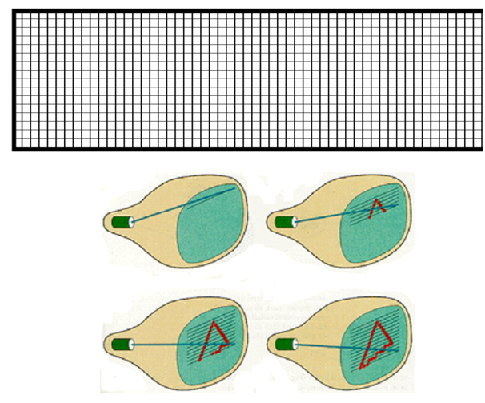Raster Scan Display
A raster scan display device utilizing CRT on the other hand directs the electron beam across the screen, one row at a time from top to bottom. In raster scan display device, the screen is supposed to consists of a two-dimensional matrix. Remember that the term raster was utilized for a 2-D matrix. Each of point of the screen corresponding to a matrix element is called as pixel (picture element) as illustrated in Figure

The refresh process should also be performed for raster scan monitors. Mostly television monitors are raster scan display devices: one scan-line at a time. Raster scan systems utilize a memory buffer called frame buffer (or refresh buffer) in which the intensities of the pixels are stored. Refreshing the screen is performed utilizing the information (intensity of each pixel) stored in the frame buffer. Frame buffer may be treated as a two-dimensional array. Raster display devices read the frame buffer and activate the three phosphor dots in the triad according to the value read from the frame buffer. The entire contents of the frame buffer must be read and the pixels must be activated appropriately at an adequately high rate to avoid flickering of the picture. Based on the persistence of the phosphor coated inside the screen, the monitors need different refresh rates. In some raster display devices, a frame buffer is displayed in two passes. This kind of refreshing is called as interlaced. In the first pass the odd rows are refreshed, when the even rows are refreshed in the second pass. Therefore, the screen is refreshed in half the time. Though this approach does not really enhance the rate of refreshing the screen, but is quite effective in reducing the flicker.
In the interlaced scan, the refresh cycle of 1/30 seconds is divided in two subcycles each lasting 1/60 seconds. The first subcycle displays the even-numbered scan lines and the second displays the odd-numbered scan lines. This technique generates an image with almost a refresh rate of 60 Hz. In non-interlaced scheme, entire scan lines are refreshed 60 times in a second or once every 1/60 seconds.
The other property of raster display devices is the number of pixels that may be shown on the screen. It is called the resolution. On a display device with a resolution of 1024 × 768, there are 768 rows (scan-lines) and in each scan line there are 1024 pixels. Aspect ratio, on the other hand, is the ratio of horizontal to vertical pixels.
In the case of raster scan displays, rasterisation (scan conversion) that is the process of converting the geometric entities to pixels in frame buffer, finds the intensity values (black or white for monochrome displays) of the pixels and sets the corresponding elements (memory locations). Thus, once the rasterisation is carrying out, the refreshing process reads the frame buffer and turns the electron beam on or off based on the intensity stored in the frame buffer.
The video controller controls the operation of the display device. Here, the frame buffer may be anywhere in the system memory. The picture to be displayed is put into the frame buffer - a fixed area of the system memory.
Video controller then retrieves the values stored in the frame buffer to set the intensity of the CRT beam for the corresponding pixels
Mostly present raster-scan systems contain a separate processor called as display processor. This processor performs graphics functions such as rasterisation and other raster operations. Frame buffer is not a fixed area in the system memory anymore. By a separate display processor, the disadvantages of a simple raster-scan system are ignored.
Its advantages are following :
1. Now Rasterisation is performed faster since a special purpose processor is utilized.
2. The CPU is not slowed down by the graphics tasks.
3. The number of memory cycles available to the CPU is more now as video controller does not access the system memory for refreshing the screen.